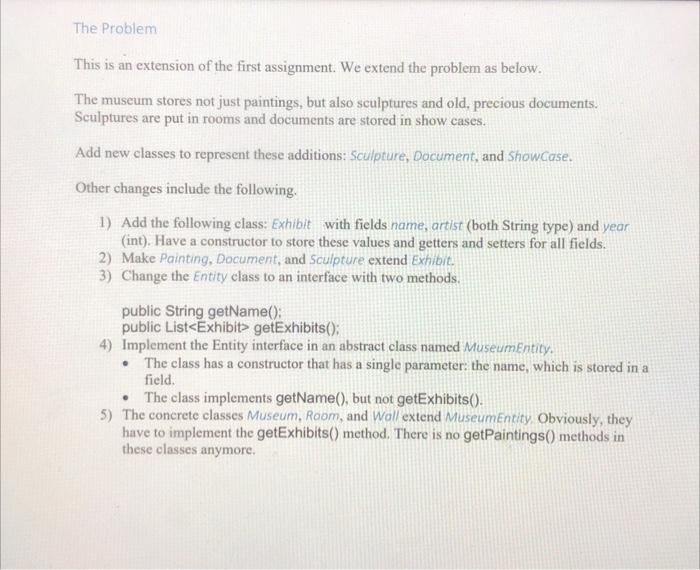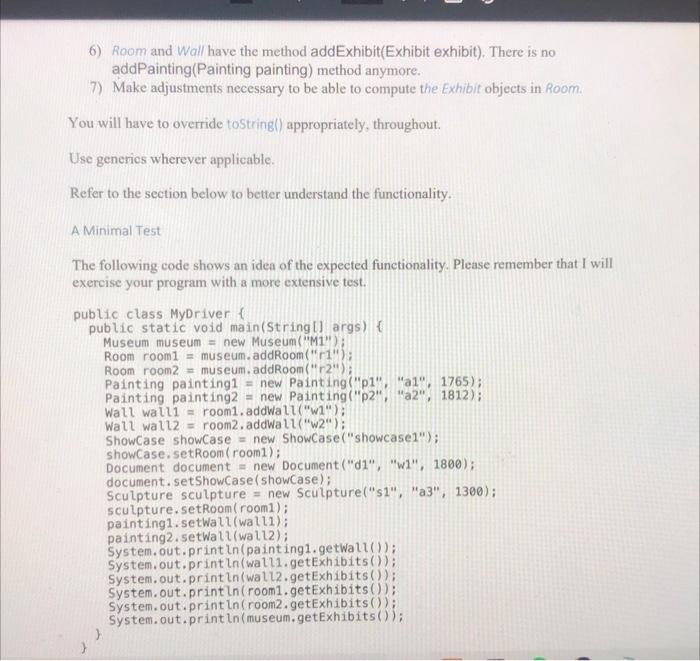Answered step by step
Verified Expert Solution
Question
1 Approved Answer
please answer this question using java Language Reposted because the previous answers were incorrect. this assignment is an extension of a previous assignment and I
please answer this question using java Language
Reposted because the previous answers were incorrect.
this assignment is an extension of a previous assignment and I provided the code for that assignment here. please answer it using java and add comments on the methods for an explanation. thanks for the help.



Previous assignment code
//package MuseumPack; public class Entity { private String name; // private attribute of string type to store the name of the this entity public Entity(String entityName) { /** * this constructor takes a String parameter named "entityName" * and assign it to private attribute name */ name = entityName; } public String getName() { return name; } } Museum.java
//package MuseumPack; import java.util.ArrayList; import java.util.List; public class Museum extends Entity { private List rooms = new ArrayList(); // this private attribute stores all the Room objects in this list public Museum(String entityName) { /** * Because Museum class extends Entity class so call the base class constructor * to initialize the base class properties */ super(entityName); } public Room addRoom(String roomName) { // this method takes a String parameter and create its named Room object and adds it to the List rooms Room newRoom = new Room(roomName); rooms.add(newRoom); return newRoom; // and returns this newly created Room object } public List getPaintings() { /** * This method returns all paintings in all room's walls in this museum object * For that we loops for each room in this museum in rooms List * then for each room, we loop for each wall * and for each wall we add its paitings to allPaintings and return its */ List allPaintings = new ArrayList(); for (Room room : rooms) { for (Wall wall : room.getWalls()) { for (Painting painting : wall.getPaintings()) { allPaintings.add(painting); } } } return allPaintings; } } Room.java
//package MuseumPack; import java.util.ArrayList; import java.util.List; public class Room extends Entity { private List walls = new ArrayList(); // List attribute to store all the walls in this room public Room(String entityName) { // constructor calls base method super(entityName); } public List getPaintings() { /** * This method returns all paintings in this room * for that, we loop for each wall * and for each wall we add its paitings to allPaintings and return this Lists */ List allPaintings = new ArrayList(); for (Wall wall : walls) { for (Painting painting : wall.getPaintings()) { allPaintings.add(painting); } } return allPaintings; } public Wall addWall(String name) { // this method first create a new Wall object Wall newWall = new Wall(name); walls.add(newWall); // adds this newly created Wall object to walls return newWall; // returns newly created Wall object } public List getWalls() { return walls; } } Wall.java
//package MuseumPack; import java.util.ArrayList; import java.util.List; public class Wall extends Entity { private List allPaintings = new ArrayList(); // List attribute to store all the Painting objects public Wall(String entityName) { // constructor super(entityName); } public List getPaintings() { return allPaintings; } public void addPainting(Painting newPainting) { allPaintings.add(newPainting); } } Painting.java
//package MuseumPack; public class Painting extends Entity { private Wall paitingWall; public Painting(String entityName) { // constructor takes String parameter and initializes the base class property super(entityName); } public void setWall(Wall paintingWall) { this.paitingWall = paintingWall; // calling Wall member method addPainting() paintingWall.addPainting(this); } public String toString() { return "Painting "+this.getName() + " set on " + this.paitingWall.getName(); } } Main.java
//package MuseumPack; public class Main { public static void main(String[] args) { Museum museum = new Museum("M1"); Room room1 = museum.addRoom("r1"); Room room2 = museum.addRoom("r2"); Painting painting1 = new Painting("p1"); Painting painting2 = new Painting("p2"); Wall wall1 = room1.addWall("w1"); Wall wall2 = room2.addWall("w2"); painting1.setWall(wall1); painting2.setWall(wall2); System.out.println(wall1.getPaintings()); System.out.println(wall2.getPaintings()); System.out.println(room1.getPaintings()); System.out.println(room2.getPaintings()); System.out.println(museum.getPaintings()); } } this is the output of the previous assignment

Step by Step Solution
There are 3 Steps involved in it
Step: 1

Get Instant Access to Expert-Tailored Solutions
See step-by-step solutions with expert insights and AI powered tools for academic success
Step: 2

Step: 3

Ace Your Homework with AI
Get the answers you need in no time with our AI-driven, step-by-step assistance
Get Started


